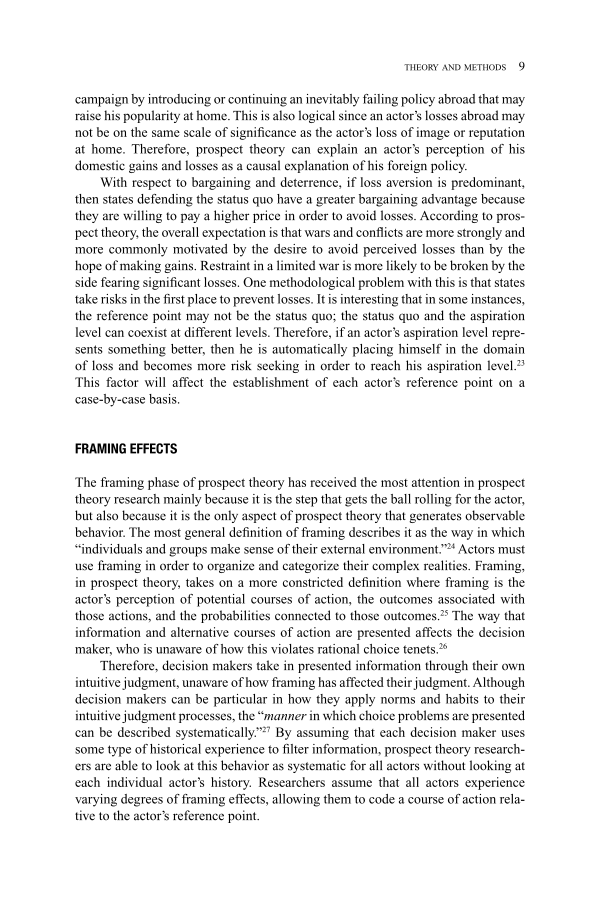THEORY AND METHODS 9 campaign by introducing or continuing an inevitably failing policy abroad that may raise his popularity at home. This is also logical since an actor’s losses abroad may not be on the same scale of signifi cance as the actor’s loss of image or reputation at home. Therefore, prospect theory can explain an actor’s perception of his domestic gains and losses as a causal explanation of his foreign policy. With respect to bargaining and deterrence, if loss aversion is predominant, then states defending the status quo have a greater bargaining advantage because they are willing to pay a higher price in order to avoid losses. According to pros- pect theory, the overall expectation is that wars and confl icts are more strongly and more commonly motivated by the desire to avoid perceived losses than by the hope of making gains. Restraint in a limited war is more likely to be broken by the side fearing signifi cant losses. One methodological problem with this is that states take risks in the fi rst place to prevent losses. It is interesting that in some instances, the reference point may not be the status quo the status quo and the aspiration level can coexist at different levels. Therefore, if an actor’s aspiration level repre- sents something better, then he is automatically placing himself in the domain of loss and becomes more risk seeking in order to reach his aspiration level. 23 This factor will affect the establishment of each actor’s reference point on a case-by-case basis. FRAMING EFFECTS The framing phase of prospect theory has received the most attention in prospect theory research mainly because it is the step that gets the ball rolling for the actor, but also because it is the only aspect of prospect theory that generates observable behavior. The most general defi nition of framing describes it as the way in which “individuals and groups make sense of their external environment.” 24 Actors must use framing in order to organize and categorize their complex realities. Framing, in prospect theory, takes on a more constricted defi nition where framing is the actor’s perception of potential courses of action, the outcomes associated with those actions, and the probabilities connected to those outcomes. 25 The way that information and alternative courses of action are presented affects the decision maker, who is unaware of how this violates rational choice tenets. 26 Therefore, decision makers take in presented information through their own intuitive judgment, unaware of how framing has affected their judgment. Although decision makers can be particular in how they apply norms and habits to their intuitive judgment processes, the “ manner in which choice problems are presented can be described systematically.” 27 By assuming that each decision maker uses some type of historical experience to fi lter information, prospect theory research- ers are able to look at this behavior as systematic for all actors without looking at each individual actor’s history. Researchers assume that all actors experience varying degrees of framing effects, allowing them to code a course of action rela- tive to the actor’s reference point.
Document Details My Account Print multiple pages
Print
You have printed 0 times in the last 24 hours.
Your print count will reset on at .
You may print 0 more time(s) before then.
You may print a maximum of 0 pages at a time.

























































































































































